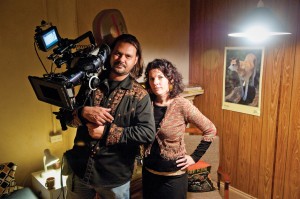Here I Am’s Beck Cole, Kath Shelper and Warwick Thorton are here to stay
 The Hollywood machine loves selling audiences ‘the new project from the creators of…’ a certain box office hit or a critically acclaimed film. It looks great on the posters, but most times it doesn’t guarantee anything.
The Hollywood machine loves selling audiences ‘the new project from the creators of…’ a certain box office hit or a critically acclaimed film. It looks great on the posters, but most times it doesn’t guarantee anything.
There are times, however, when such a reference is not just an empty marketing tool, but a real promise of the aesthetic and creative capabilities of a close-knit group of collaborators.
Here I Am, from the creators of Samson & Delilah, is one of those cases. Married couple Beck Cole and Warwick Thornton have created a powerful creative partnership with producer Kath Shelper. They call themselves the ‘Trinity’ and together they’ve made critically acclaimed short films and documentaries, as well as Australia’s 2009 Camera d’Or winner at Cannes.
“Warwick, Bec and I have been working as a team for the last seven years,” explained Shelper.


where is the movie being screened in wa or can we buy it.
Hi Barbara,
Here you are for screenings
http://www.lunapalace.com.au/i.....8;cinema=1
And to buy the DVD keep an eye the news on:
http://www.hereiamfilm.com
hi,i was an xtra in ‘here i am’and didnt get 2 go 2 the screening,i cant wait 2 c the movie.im really hoping u remember me,i was the 1 standing in the doorway of the cell with a ciggie i was wondering if u might b able 2 tell me of casting agencies and that perhaps u might b able 2 consider me 4 future parts(even if its just as an xtra!)i would love 2 be apart of ur exciting adventures of film making!i hope u hav time 2 get bak 2 me and congratulations on the standing ovation!best of luck with ur future projects!